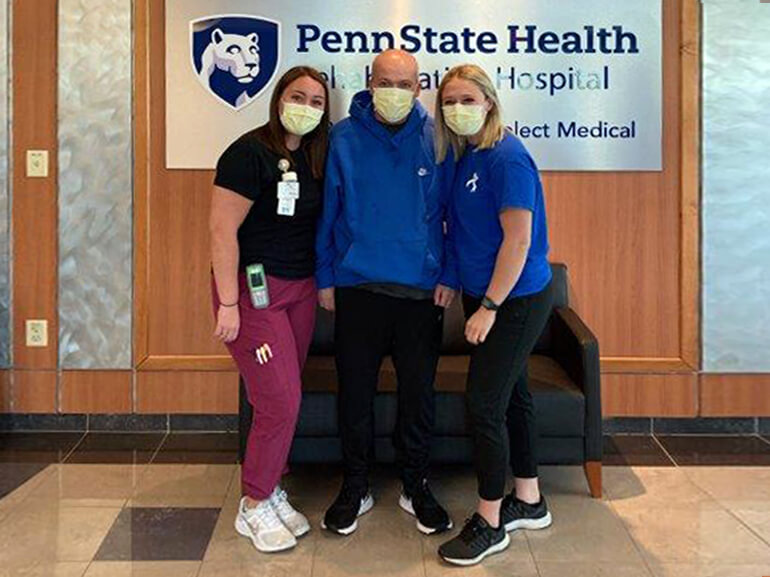Jeremy's story

Jeremy Bashore, 52, faced a life-altering event after a severe motor vehicle accident left him with a traumatic brain injury and many fractures and internal injuries throughout his body. Further stressing his body, he had COVID-19 and had to be placed on a ventilator and feeding tube to breathe and supply nourishment, respectively. He was also receiving antibiotics to halt the infection. After two months of acute care and gradual medical improvement, he transferred to Penn State Health Rehabilitation Hospital to continue his recovery.
Upon his arrival at Penn State Rehabilitation Hospital, Jeremy’s physical and cognitive impairments were substantial. His physician-led interdisciplinary care team assessed him and mapped out a care plan that would include physical, occupational and speech therapy.
His doctor prescribed medicines to help care for Jeremy and manage his behavioral challenges throughout his rehabilitation. Over his stay, Jeremy’s pharmacist worked with his physician to reduce sedating medications, stabilize his sleep-wake cycle, address safety concerns and manage behavioral issues and pain.
Nursing staff initially used an enclosure bed – a specialty bed that features a mesh tent connected to a frame placed over a standard hospital bed — and a rear fastening seatbelt to ensure Jeremy’s safety; as a brain injured patient he was prone to restlessness. They also provided care by administering his medications and providing supervision to protect his feeding tube during his bouts of restlessness.
As he started therapy, Jeremy needed two therapists to help him stand and move in and out of his bed. He required constant reminders to safely engage in therapy tasks and he couldn’t eat or drink my mouth as he still relied on his feeding tube. In addition, his left arm remained immobilized due to fractures sustained during the accident.
Physical therapy (PT) initially focused on sitting balance, transfers, lower extremity strengthening and his ability to stand for longer period of time – all to work towards a goal of improved functional mobility. PT started by having Jeremy sit on the edge of a large mat table and reach in various directions to grasp cones and bean bags. This worked to increase his trunk strength which in turn and over time, allowed him to safely sit up without assistance. As Jeremy’s sitting balance improved, his therapists helped him stand for increasingly longer periods of time to help build leg strength. When Jeremy was able to safely stand without frequently losing his balance, he progressed to activities to further strengthen his legs. He worked on a range of activities standing on one leg such as kicking cones on the floor and tapping his foot on a small step.
With his core and leg strength improving, Jeremy began walking with the help of a handrail and a wheelchair in tow, to maximize his safety. As he built strength, Jeremy progressed to a single point cane and assistance from a therapist. As he readied for discharge, Jeremy could safely walk independently without a device inside and outside.
As Jeremy’s balance, walking, and cognition improved, physical therapy focused on dual tasking while walking. He was frequently challenged to perform cognitive tasks while walking such as naming as many fruits as possible, collecting single digit numbers to create multi-digit numbers and performing basic math while doing an obstacle course.
Meantime, Jeremy’s occupational therapists worked to enhance his balance, strength and endurance related to self-care tasks such as bathing, dressing and toileting. His cognition was also a key focus in occupational therapy (OT) sessions since he eventually wanted to care for himself. Jeremy worked on an array of cognitive exercises such as reaching for bean bags and reading the word on the bean bag, throwing a ball and naming a different animal or food with each throw and organizing a deck of cards into piles by color, then into piles by suit for an increased challenge. As Jeremy’s mobility and cognition grew, he participated in practice and actual activities of daily living during OT sessions including showering, getting dressed, grocery shopping, doing laundry and money management.
Speech therapy worked on liberating Jeremy from the feeding tube. Since he had not eaten by mouth for months, his therapists first introduced ice chips and small sips of water to get Jeremy’s swallowing muscles working more consistently and in unison. As his cognitive status improved and he was able to tolerate the ice and water, small amounts of pureed food were trialed and a swallow study using an x-ray was completed. It showed he was able to tolerate thicker foods and slowly move to a regular diet of solid foods. Before he discharged, Jeremy was enjoying a regular diet and his feeding tube was removed.
Despite tremendous obstacles, Jeremy maintained a positive attitude, unwavering work ethic and his sense of humor. His family’s support through frequent visits also played a crucial role in his recovery. After 41 days in Penn State Health Rehabilitation Hospital, Jeremy discharged to continue rehabilitation at a regional medical facility close to his home. Jeremy eventually moved back home and is now able to walk independently and manage all his self-care needs.